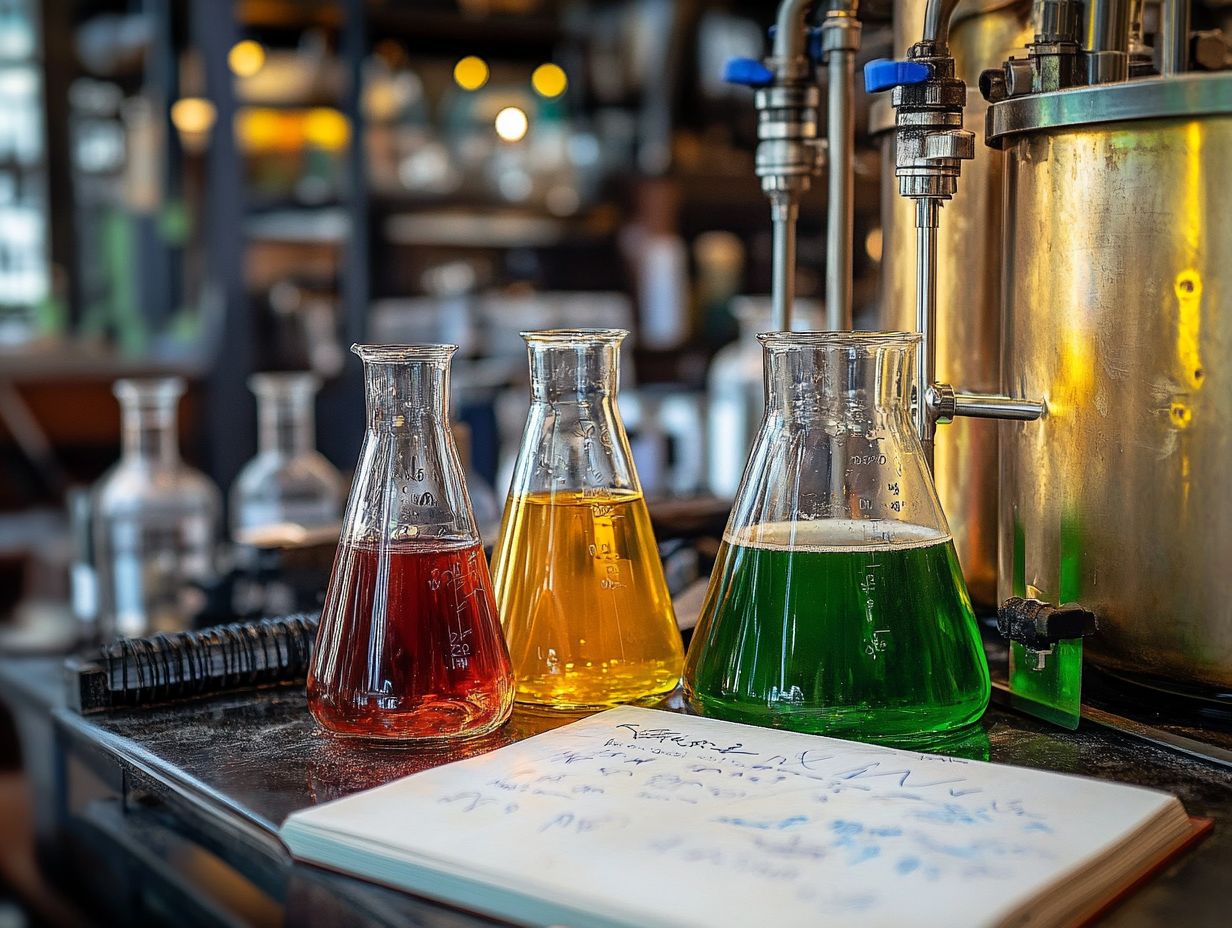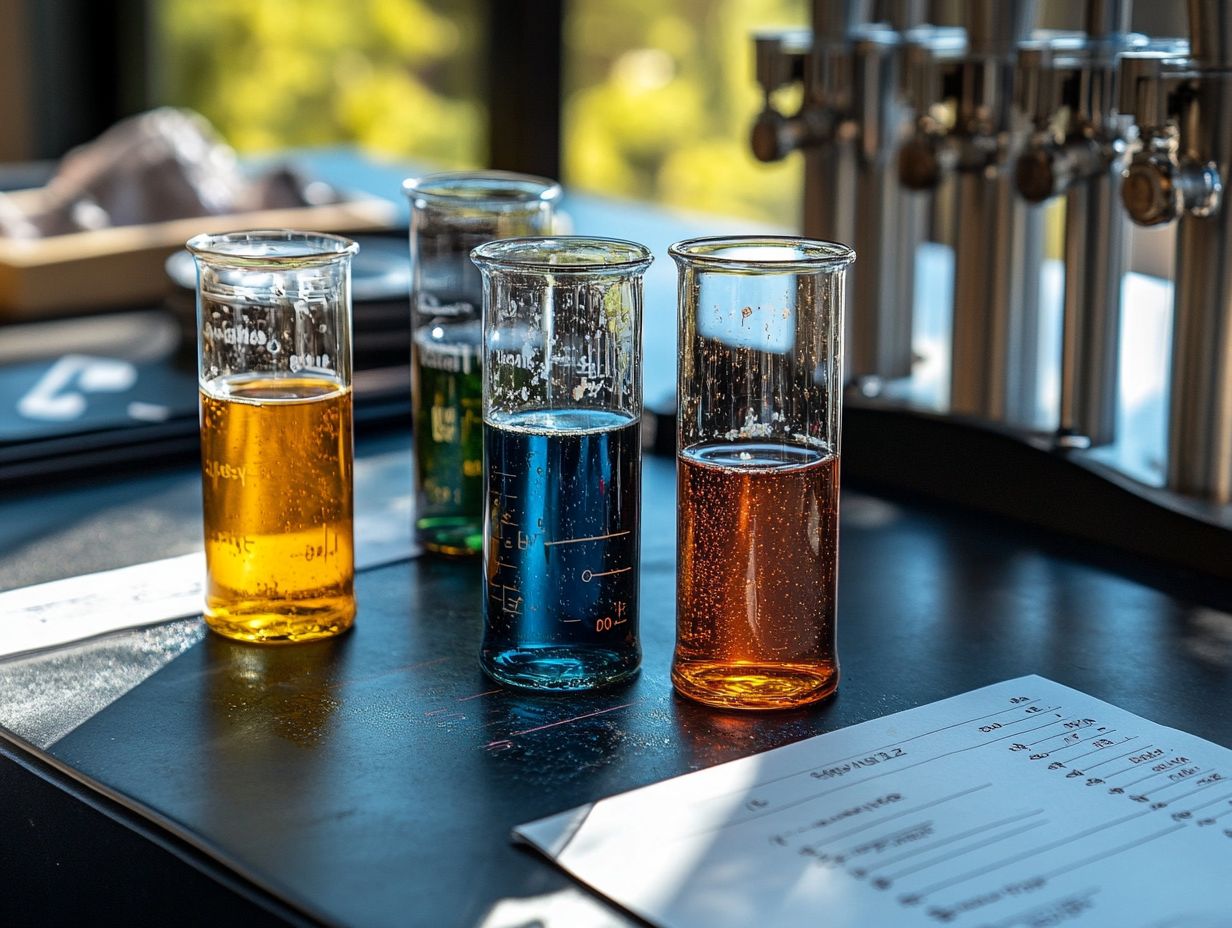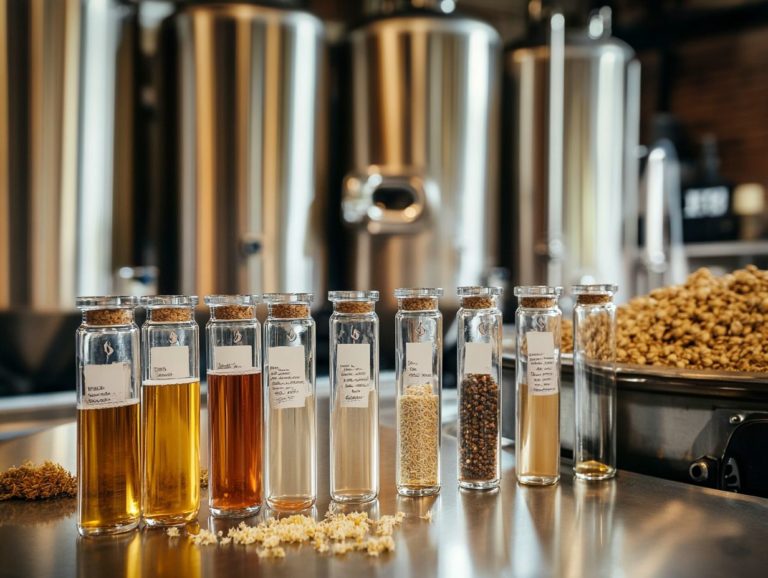Understanding Water Chemistry in Brewing
Water chemistry is pivotal in the brewing process, shaping everything from flavor profiles to fermentation efficiency. Both surface water and groundwater aquifers contribute to the unique water profiles available for brewing.
This article delves into the complexities of water chemistry in brewing, emphasizing its essential components and how they influence various beer styles. Discover how to fine-tune your water chemistry for optimal outcomes, sidestep common mistakes, and effectively monitor your water quality!
Whether you’re an experienced brewer or a newcomer to the craft, mastering water chemistry can elevate your brewing endeavors to remarkable new heights.
Contents
- How Can You Adjust Water Chemistry for Brewing?
- What Are the Common Mistakes in Adjusting Water Chemistry for Brewing?
- How Can You Test and Monitor Water Chemistry for Brewing?
- What Are the Best Practices for Maintaining Water Chemistry in Brewing?
- Frequently Asked Questions
- What is the role of water chemistry in brewing?
- What are the main components of water that impact brewing?
- How does pH affect the brewing process?
- What minerals are important for brewing?
- How does water hardness affect the brewing process?
- Can water chemistry be adjusted for different beer styles?
Key Takeaways:

- Water chemistry plays a crucial role in the brewing process, affecting everything from taste to fermentation. Regular adjustments using brewing salts like gypsum and Epsom salt can help maintain consistency.
- Understanding key elements and their effects on beer styles helps brewers adjust water chemistry for optimal results.
- Regular testing and monitoring of water chemistry, along with best practices, can help maintain consistency in beer quality.
What Is Water Chemistry in Brewing?
Water chemistry in brewing involves understanding how various elements and compounds in your water impact the brewing process. This is particularly important for creating different beer styles.
Pay attention to the mineral content such as calcium, magnesium, sodium, sulfate, and chloride because these play pivotal roles in shaping the flavor, mouthfeel, and overall quality of your beer. Utilizing tools like a LaMotte BrewLab can help you effectively measure and manage these components.
By grasping the balance of these minerals, you can customize your brewing water to achieve specific characteristics, whether that s a crisp Pilsner or a bold American IPA. It s essential to understand total alkalinity the capacity of water to neutralize acids and total hardness the concentration of calcium and magnesium as they influence mash pH and overall brewing efficiency in this intricate craft.
Why Is Water Chemistry Important in Brewing?
Understanding water chemistry is crucial in brewing because it profoundly impacts the entire brewing process, the quality of the beer, and how well the final product aligns with desired beer styles. Analyzing your water report is one of the first steps toward making informed adjustments.
Adjusting your brewing water can significantly influence the flavor profile, mouthfeel, and overall stability of your beer. This highlights the necessity of tailoring your approach to meet the specific requirements of each beer style.
Accurate pH measurement and precise water profile adjustments can elevate your brewing process, resulting in beers that are not only pleasurable to drink but also consistently high in quality whether you re crafting an Oktoberfest, a classic American Pale Ale, or a Hazy IPA.
Now is the time to experiment with your water chemistry and share your brewing experiences!
What Are the Key Elements in Water Chemistry for Brewing?
The key elements in water chemistry for brewing are essential minerals like calcium, magnesium, sodium, sulfate, chloride, and bicarbonate. Each plays a critical role in the brewing process. For example, the calcium cation is particularly vital because it contributes to enzyme activity, which involves the processes that help convert starches into sugars, and helps you achieve the optimal mash pH. Regular testing using tools like LaMotte BrewLab can ensure accurate pH measurement.
Understanding the sulfate-to-chloride ratio is crucial for crafting specific beer styles. Whether you’re aiming for a crisp Pilsner or a robust, hoppy American IPA, managing this ratio can make a significant difference. You can strategically use brewing salts such as sodium chloride and Epsom salt to enhance the mineral profile of your brewing water, leading to a more refined final product.
Each of these minerals interacts uniquely during fermentation, influencing not just flavor but also mouthfeel and clarity. For instance, magnesium boosts yeast metabolism, while sodium can add a touch of sweetness to your brew.
Begin by analyzing your water reports to assess mineral concentrations. This analysis will allow you to make informed adjustments. Understanding how bicarbonate affects pH and how sulfate sharpens bitterness against the softness supplied by chloride helps you fine-tune your water chemistry.
This careful manipulation fosters a harmonious balance in your brew, resulting in a beer that truly stands out in both taste and quality. It aligns perfectly with your brewing vision. Effective use of mineral salts and a deep understanding of various water sources can guide these adjustments.
How Does Water Chemistry Affect the Brewing Process?
Water chemistry plays a pivotal role in your brewing process, affecting critical factors like mash pH, total alkalinity, and the overall mineral content of your brewing water.
A carefully balanced mash pH is essential for optimal enzyme activity during mashing. This directly influences the extraction of fermentable sugars and flavors. If not managed properly, variations in total alkalinity and total hardness can lead to undesirable flavors and brewing inefficiencies.
By understanding these dynamics, you can tailor your water profiles to achieve your desired outcomes. This knowledge allows for perfecting the brewing process for various beer styles.
What Are the Effects of Different Water Profiles on Beer Styles?

Different water profiles significantly influence specific beer styles, shaping their flavor, aroma, and mouthfeel in remarkable ways. Take, for example, the water profile of Burton-upon-Trent, renowned for its high sulfate levels. This makeup is perfect for brewing hoppy beers like the American IPA, as it enhances the perceived bitterness and dryness that beer lovers crave.
Conversely, the soft water of Pilsen is ideal for crafting delicate lagers, promoting the clean and crisp flavors that define this style. By grasping how mineral salts and their concentrations affect the brewing process, you can create beers that not only honor traditional styles but also cater to contemporary taste preferences.
In places like Munich, the calcium-rich water contributes to the rich malt character that M rzen and Dunkel styles are known for, imbuing them with a significant depth of flavor that defines these German classics. Meanwhile, the water from the Czech town of Pilsen, with its low mineral content, sets the stage for producing the famous Pilsner, celebrated for its light and refreshing qualities.
Each unique water source not only inspires innovative brewing techniques but also fosters a deeper connection to local traditions and brewing heritage. This ultimately enriches the beer experience for enthusiasts around the globe.
We encourage you to experiment with your water profiles to see the effects on taste and quality. Discover how making small adjustments can lead to remarkable outcomes in your brewing journey!
How Can You Adjust Water Chemistry for Brewing?
Adjusting water chemistry for brewing requires a series of strategic tweaks to tailor the mineral content to the specific needs of your chosen beer style. You ll often find yourself adding brewing salts like gypsum, Epsom salt, and sodium chloride to modify the balance between sulfates and chlorides, enhancing those distinct flavor profiles that make your brews shine.
Don’t overlook the power of Campden tablets; they re invaluable for treating chlorine or chloramine in your water, ensuring a clean and flawless brewing process. By mastering these adjustments, including the strategic use of brewing salts, you can craft water profiles that perfectly align with your desired flavor outcomes, whether you’re brewing a rich Oktoberfest or a vibrant Hazy IPA.
What Are the Different Methods for Adjusting Water Chemistry?
You have a variety of methods at your disposal for adjusting water chemistry, each tailored to enhance your brewing process and achieve the perfect mineral balance. Common techniques include adding brewing salts like gypsum, Epsom salt, and calcium chloride, specifically aimed at optimizing the balance between sulfates and chlorides.
You might also consider using reverse osmosis systems to create a blank slate for your water adjustments, granting you precise control over the mineral content.
Every method demands careful thought regarding the desired beer style and its unique water profile, ensuring that the final product meets your quality expectations.
In practice, you ll often start by analyzing your base water with comprehensive testing kits that reveal existing mineral levels. This invaluable data will guide your choices of salts and treatments, helping you align them with the specific requirements of various beer styles, whether it s an IPA or a stout.
Over time, many brewers like yourself keep meticulous logs of adjustments, tracking how changes in water chemistry influence flavor, mouthfeel, and overall beer quality. This record-keeping not only promotes consistency but also allows you to refine your techniques, experimenting with different ratios to perfect your craft.
These methods deepen your understanding of the brewing process and enhance your ability to create exceptional beers.
What Are the Recommended Water Profiles for Different Beer Styles?
Each beer style comes with its own recommended water profiles, perfectly aligned with its unique flavor and character, highlighting the essential role of mineral content in the brewing process. For example, if you dream of brewing a hoppy American IPA, don’t wait to adjust your sulfate levels it enhances that bitterness you crave.
On the flip side, for a smooth, malt-forward beer such as Oktoberfest, you ll want a balanced calcium and bicarbonate level to achieve that rich, inviting profile.
By understanding these recommended water profiles, you can fine-tune your brewing water to complement and elevate the specific style you re creating. Adjusting your water based on the report can yield the best results.
Take a German Pilsner, for instance. It flourishes with lower mineral levels, preferring soft water think sulfate around 50 ppm and a careful focus on calcium at about 40 ppm to ensure that crisp finish. On the other hand, stouts thrive on elevated chloride levels, typically in the range of 75-100 ppm, giving you that luscious mouthfeel and rounded flavor you desire.
To effectively track and replicate these profiles, you ll likely find water chemistry analysis tools and brewing software invaluable. They allow you to replicate historical water conditions from places renowned for their brewing traditions, enabling you to craft exceptional beers with precision.
What Are the Common Mistakes in Adjusting Water Chemistry for Brewing?
Watch out! Common mistakes in adjusting water chemistry can derail your brewing game, ultimately affecting both the flavor and quality of your final beer.
One prevalent error is overcompensating with mineral salts, which can create imbalances that detract from your desired flavor profile. Another frequent misstep is neglecting to consult a detailed water report, which provides essential information on existing mineral content and alkalinity levels.
By recognizing these pitfalls, you can steer clear of costly mistakes and elevate your brewing outcomes, ensuring consistency and quality in every batch of beer you create.
How Can You Test and Monitor Water Chemistry for Brewing?

Testing water chemistry is crucial for brewers. It helps create optimal conditions during the brewing process. Pay close attention to parameters like pH measurement, total hardness, and mineral content.
By conducting regular tests, you can maintain a consistent water profile, allowing you to make informed adjustments based on your water reports. Utilizing specialized testing kits or laboratories can offer comprehensive insights into your water’s chemistry, enabling you to fine-tune your processes and consistently achieve high-quality results with every batch you brew.
What Are the Key Parameters to Measure in Water Chemistry for Brewing?
Key parameters to measure in your water chemistry for brewing include pH levels, total alkalinity, total hardness, and the concentrations of essential minerals such as calcium, magnesium, sodium, sulfate, and chloride. Monitoring these parameters is crucial, as they directly influence your brewing process and the flavor profile of the final beer.
Aim for a target mash pH between 5.2 and 5.6 to ensure optimal enzyme activity during mashing. By understanding and adjusting these parameters, you can create water profiles that cater to the specific requirements of your chosen beer styles.
Each parameter works together intricately, determining the efficiency of chemical processes, especially during mashing, where starches are converted into fermentable sugars. For example, high levels of total hardness can bolster yeast stability and enhance the mouthfeel of your beer, while a proper balance of sodium and chloride can refine the flavor, adding body without overpowering the hops.
To accurately measure these parameters, use reliable testing kits and pH meters, conducting regular water analyses to identify necessary adjustments. These practices improve consistency and enable you to craft distinct beers that align with your unique brewing vision.
What Are the Recommended Tools for Testing Water Chemistry?
In terms of testing water chemistry in brewing, utilize a range of sophisticated instruments and kits designed to deliver precise measurements of crucial parameters like pH, total alkalinity, and mineral content. The LaMotte BrewLab stands out as a premier testing solution, offering detailed analysis that every brewer can appreciate.
Portable pH meters and chemical test strips provide flexibility for immediate assessments, allowing you to make timely adjustments to water quality during the brewing process.
If you re in the mood for a deeper dive, consider using spectrophotometers that measure specific ions and compounds, offering intricate insights into your water’s composition. For added convenience, smartphone apps that sync with test kits simplify the process of data recording and trend tracking, seamlessly integrating water chemistry insights into your daily brewing rituals.
These advanced tools refine your brewing process and help maintain consistent flavor profiles, ensuring that every batch aligns with your brewery’s standards. By incorporating these sophisticated testing instruments into your routine, you can elevate your craft and produce exceptional beers that truly capture the essence of your local water sources.
What Are the Best Practices for Maintaining Water Chemistry in Brewing?
To maintain optimal water chemistry in brewing, adopt a proactive approach to monitoring and adjusting your brewing water, ensuring consistent quality throughout the brewing process. This involves regularly testing your water samples and consulting water reports to gain insights into the mineral content.
Make informed adjustments based on the specific requirements of your beer styles to elevate your brewing experience. Establish a standard operating procedure for water chemistry management to streamline your processes, achieving exceptional results with every batch brewed.
Watch this video to explore the importance of water chemistry in brewing.
Frequently Asked Questions
Don’t miss out on the chance to perfect your water chemistry! Feel free to explore the following FAQs to deepen your understanding and enhance your brewing journey.
What is the role of water chemistry in brewing?

Water chemistry is a game-changer in brewing! It directly influences the taste, aroma, and quality of your beer.
What are the main components of water that impact brewing?
The main components of water that impact brewing are pH, mineral content, and water hardness.
How does pH affect the brewing process?
The pH level can greatly impact beer flavor. A higher pH can result in a more alkaline, bitter taste.
In contrast, a lower pH can lead to a more acidic, sour taste.
What minerals are important for brewing?
Magnesium, calcium, and sulfate are essential minerals that contribute to the flavor and body of the beer.
How does water hardness affect the brewing process?
Water hardness refers to the amount of minerals, such as calcium, magnesium, and bicarbonates, in the water.
It can greatly impact the effectiveness of enzymes during mashing, which is the process where crushed grains are soaked in water to extract sugars, and the overall clarity of the beer.
Can water chemistry be adjusted for different beer styles?
Absolutely! You can tweak water chemistry for specific beer styles to unlock incredible flavors.
For example, a higher sulfate content is ideal for hoppy beers, while a lower sulfate content works better for malty beers.
Understanding water chemistry in brewing is crucial for creating unique and delightful beer styles. Dive deeper into the topic to elevate your brewing game!






